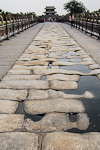 (Written July 13, 2012 in Beijing)
(Written July 13, 2012 in Beijing)
Known in the West as the Marco Polo Bridge, the Lugouqiao or Bridge Over the Reed Ditch, is important in China for three reasons: It was mentioned in The Travels of Marco Polo, allegedly written by the Italian traveller describing his travels in Yuan Dynasty (1271–1368) China; an inscription written by Qing Dynasty (1644–1911) Emperor Qianglong (ruled 1735–96) and the Marco Polo Bridge Incident from July 7–9, 1937, sparking the Chinese War of Resistance Against Japanese Agression and China's entry into what would become World War II in the Asia-Pacific. The bridge itself is an architecturally significant structure built of granite with 11 arches that was restored by the Qing's Kangxi Emperor (1662–1722).
If you travel to the bridge, which spans what was once a mighty Yongding river, plan on spending about a day exploring and photographing the bridge, which is still used for local transportation. See also the new park being built along the re-filled river's banks and Wanping Town just east of the bridge, which was once a major portal for entering old Beijing. Inside the old town is the Memorial Museum of the Chinese People's Anti-Japanese War (which I have yet to visit), interesting shops with some items seldom found elsewhere and entertainment attractions.
South of the old town's walls is a sculpture garden containing four-sided sculptures that portray various scenes of the people's struggles during the war era. These sculptures are better than much of the public art found elsewhere in China.
East of the old town, there is a lively street market, restaurants and lots of shaded places to sit and relax.
Photographically speaking, I've been to the bridge several times with various pieces of equipment. I still haven't captured a "great" picture of the area, and I've usually been bound to being there only at midday when shooting conditions are not good.
But it's an interesting place to shoot and spend some time and should become moreso with the re-development of the area as a natural, historic park. Unfortunately, new elevated train tracks to the west of the bridge detract somewhat from scenic views of the mountains a bit further to the west.
It's a popular place for locals to spend the night of the Mid-Autumn Festival when the moon is at its fullest.
Dukes